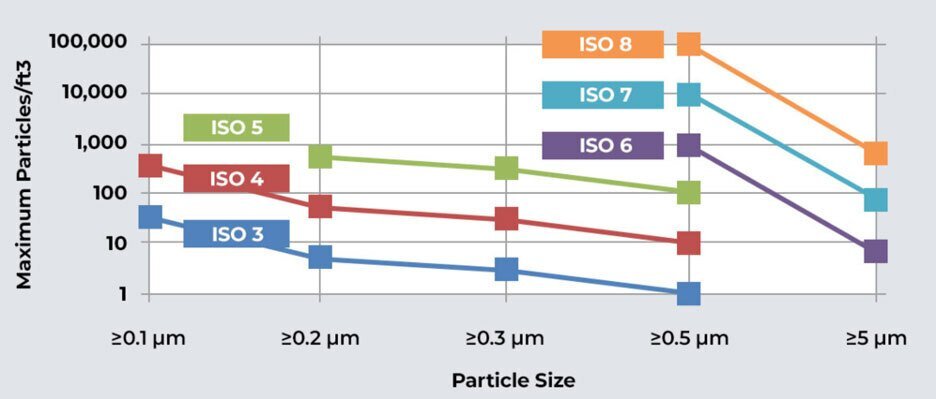Clean Room Class: Understanding Different Clean Room Standards
- 2024-01-27
- View 9
In various industries such as pharmaceuticals, electronics manufacturing, and research laboratories, maintaining a clean and controlled environment is of utmost importance Clean rooms are designed to achieve precisely that. These specialized environments have controlled levels of pollutants, such as dust, microbes, and aerosol particles, to ensure optimal conditions for sensitive processes and products Clean rooms are classified into different classes based on their cleanliness level, as defined by international standards. Let's explore the clean room classes and their associated requirements.

Class 1: The Strictest Clean Room Standard
Class 1 clean rooms are the most stringent and demanding in terms of cleanliness. These clean rooms have the lowest allowed particle count per cubic meter of air. The maximum particle size allowed is 0.1 micrometers. Class 1 clean rooms are typically found in industries such as semiconductor manufacturing, nanotechnology, and advanced research facilities. Achieving and maintaining the cleanliness requirements of Class 1 clean rooms require sophisticated air filtration systems, rigorous cleaning procedures, and meticulous control of personnel and equipment.
Class 10: High-Level Cleanliness for Critical Applications
Class 10 clean rooms have a slightly higher particle count per cubic meter compared to Class 1 clean rooms. The maximum allowable particle size is 0.5 micrometers. These clean rooms are commonly used in industries where precision is crucial, such as pharmaceutical manufacturing, optical device production, and medical device manufacturing. Class 10 clean rooms require advanced air filtration systems, strict gowning protocols, and regular monitoring to maintain the desired cleanliness level.
Class 100: Widely Used Clean Room Standard
Class 100 clean rooms have a higher particle count per cubic meter compared to Class 10 clean rooms. The maximum allowable particle size is 0.5 micrometers Class 100 clean rooms are commonly employed in industries like electronics manufacturing, aerospace, and biotechnology. These clean rooms are less restrictive in terms of cleanliness requirements but still demand careful control of contamination sources and adherence to strict protocols.
Class 1,000 and Class 10,000: Lower Stringency, Wider Applications
Class 1,000 and Class 10,000 clean rooms have higher particle counts compared to the previous classes. The maximum allowable particle size for both classes is 1 micrometer. These clean rooms are employed in industries such as automotive manufacturing, food processing, and general research facilities. While they have less stringent cleanliness requirements, they still require effective air filtration systems, controlled airflow, and regular monitoring to ensure the desired cleanliness level.
Clean Room Standards and ISO Classification
Clean room standards are defined by organizations such as the International Organization for Standardization (ISO) to provide uniformity and a common framework for clean room classification worldwide ISO 14644-1 is the widely accepted standard that defines the classification of air cleanliness in clean rooms based on particle count and size distribution. The ISO standard outlines the maximum allowable particle counts for different clean room classes and provides guidelines for testing and monitoring.
Factors Influencing Clean Room Classification
Several factors influence the classification of clean rooms:
1. Particle Count
The primary factor in clean room classification is the permissible particle count per cubic meter of air. Different clean room classes have specific limits on the number of particles allowed, and these limits decrease as the class becomes stricter.
2. Particle Size
Clean room standards also specify the maximum allowable particle size. This ensures that larger particles, which may pose a greater risk to sensitive processes and products, are effectively controlled.
3. Airflow and Ventilation
The airflow and ventilation systems in clean rooms play a crucial role in maintaining the desired cleanliness level. Properly designed airflow patterns and filtration systems help remove and control particles, ensuring a clean environment.
4. Gowning and Personnel Control
Strict protocols for gowning, personnel hygiene, and behavior are essential in clean rooms. Contamination from human sources, such as skin flakes and microorganisms, can be a significant challenge. Adherence to gowning protocols and controlled access minimize the introduction of contaminants.
5. Equipment and Material Handling
Clean rooms require careful handling of equipment and materials to prevent contamination. Specialized procedures, such as cleaning and sterilization of tools and materials, are implemented to maintain cleanliness.
Conclusion
Clean rooms are vital in industries where contamination control is critical for product quality, safety, and reliability. Understanding the different clean room classes and their associated requirements is essential for designing, operating, and maintaining clean room facilities. By adhering to international standards and implementing stringent cleanliness protocols, industries can ensure optimal conditions for their sensitive processes and achieve the desired level of cleanliness.
FAQs
Q1: Are clean room standards consistent across different industries?
A1: While the fundamental principles of clean room classification are similar, specific industries may have additional requirements or stricter cleanliness standards based on their unique processes and products.
Q2: Can clean room classifications change over time?
A2: Yes, clean room classifications can change based on the evolving needs of industries, advancements in technology, and updates to clean room standards and regulations.
Q3: How often should clean rooms be monitored for particle counts?
A3: Monitoring frequency depends on the industry, clean room class, and specific requirements. Typically, clean rooms are regularly monitored to ensure compliance with cleanliness standards.
Q4: Can a clean room be upgraded to a higher class?
A4: Yes, it is possible to upgrade a clean room to a higher class by implementing necessary changes and improvements in the filtration system, airflow control, gowning protocols, and other relevant factors.
Q5: What are the consequences of not maintaining the cleanliness requirements of a clean room?
A5: Failing to maintain the cleanliness requirements of a clean room can lead to product contamination, compromised processes, reduced product quality, and potential safety hazards, depending on the industry and application.
Kwang Cleanroom is proud to offer examples of a variety of our cleanroom projects below. ISO 4 Cleanroom, Dust-Free Clean Room, Clean Room Level, Hospital Operating Theater Room, Cosmetics Clean Room Engineering, Laboratory Clean Room, Operating Room Purification Engineering.
